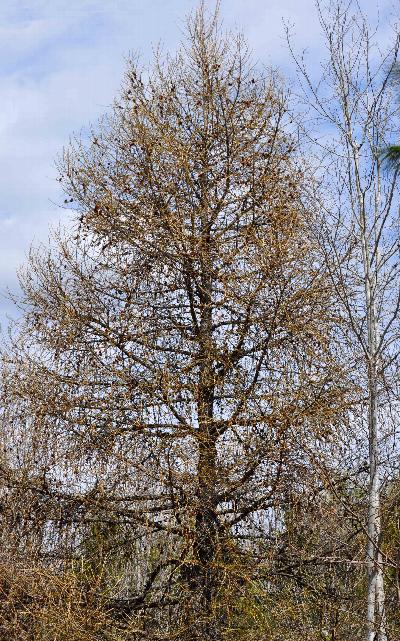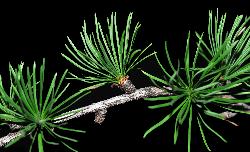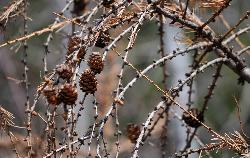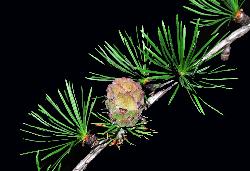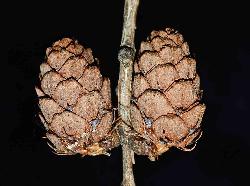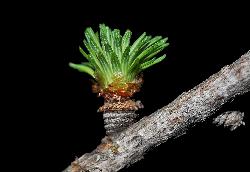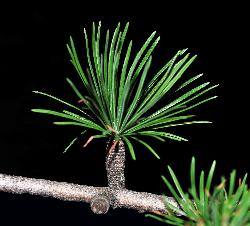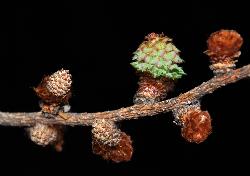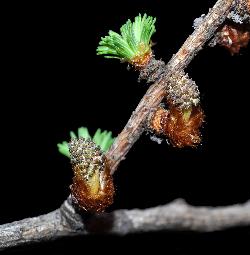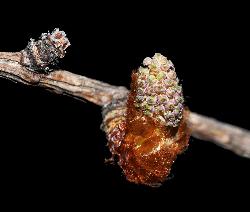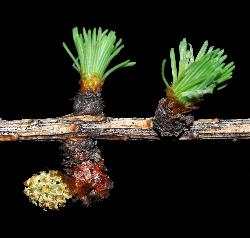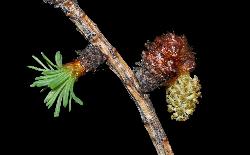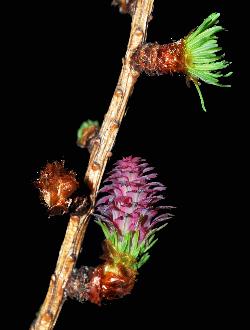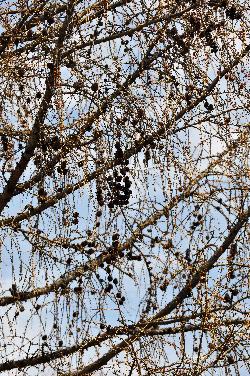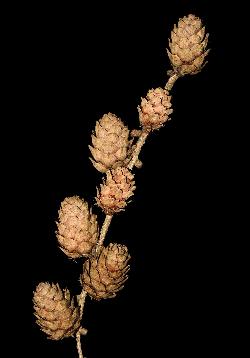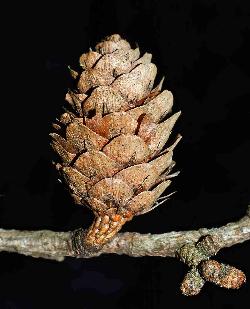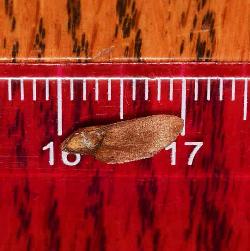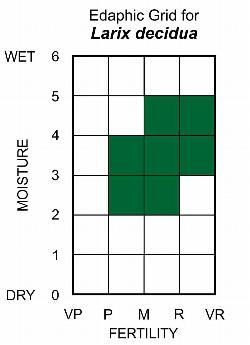Note: Numbers provided in square brackets in the text refer to the image presented above; image numbers are displayed to the lower left of each image.
General: A medium-sized, deciduous conifer tree, native to the Central Europe, primarily the mountainous Alps, Sudetes, and Carpathian regions (Matras and Pâques 2015). European larch is 25–35 m tall, with a d.b.h. of up to 100 cm (Eckenwalder 2009), it is a fast-growing species and can live to about 250 years (Matras and Pâques 2015, Woodland Trust 2015). European larch has a narrowly conical profile with ascending to drooping branches [1]. Its needles are mainly borne in tufts on short shoots [2]. European larch is a shade-intolerant, pioneer species on newly disturbed land and abandoned farmland, and is used as a 'nurse species', to prepare open land for afforestation in Europe (Matras and Pâques 2015).
Key Features:
1. Spur shoots produce tufts of 30–55 needles [2], each 2–5 mm long, while leaders bear single needles with decurrent bases.
2. Seed cones are ovoid, 2.5–4 cm long, with 40–60 broadly ovate cone scales [3].
3. Cone scales of conelets are finely pubescent on both surfaces [4]; scales of mature cones have margins that turn inward slightly [5].
Stems/twigs: Young twigs are yellowish-brown and glabrous; older twigs are greyish-brown to grey. Twigs have reddish-brown scaly buds, blunt to rounded, and about 3 mm long. Two types of shoots are produced on larch species: long shoots and spur shoots. The terminal long shoots, or leaders, are slender, with individual needles attached spirally along the shoot; leaders produce both terminal and lateral buds, and are responsible for vertical and horizontal growth of the tree. Spur shoots are short and stout, 2–3 mm across, dark brown, borne laterally on year-old and older stems, and produce new tufts of needles each year; spur shoots produce terminal buds, but do not produce lateral buds. Rows of minute leaf scars encircle the top of spur shoots [2]. The bark of mature trees is grey and scaly to furrowed, with reddish-brown inner bark.
Needles: Deciduous, simple, and sessile. Needles are slender, soft, glabrous, 2–5 cm long by 0.5–1 mm wide, bright green, and flat above with a prominent midrib beneath [6] (Farrar 1995); 1–3 thin green lines (rows of stomates) along either side of the midrib on the lower needle surface (Eckenwalder 2009). The tips of the needles are blunt to rounded. On long shoots, needles are spirally arranged and attached directly to the stem by flat decurrent woody bases. On spur shoots, needles are crowded in terminal tufts of 30–55 [6–7]. European larch needles turn yellow orange in autumn before falling.
Reproductive structures/cones: Unisexual (trees monoecious), with separate male and female cones often appearing on the same branch [8] and emerging with the needles. Male cones, 4–6 mm in diameter, consist of a nearly spherical to ovoid cluster of light reddish-brown to yellow anthers [9–12] terminating a spur shoot that lacks needles. Pollination is by wind (anemophily). Emerging female cones (conelets) are green to deep pink, ovoid, terminal on spur-shoots, and subtended by a few needles [13–14]. Immature seed cones are pale green with reddish margins, and finely pubescent on both surfaces [4, 15]; mature seed cones [16–18] are reddish-brown to brown, ovoid, 2.5–4 cm long, stalked, with a peduncle 5–10 mm long [18], erect, and have 40–60 cone scales with broadly rounded margins, often truncate to depressed at the apex, and curve slightly inward [5]; cone scales exceed the subtending bracts, which are 5–6 mm long (Eckenwalder 2009). Cones develop in late spring and mature in fall. The seeds [19] are 3–4 mm long with a 5–10 mm long wing, and are shed from the persistent cones at the end of the first growing season.
Ecology and Habitat: European larch is a native of central Europe mainly in mountainous regions and on lowlands only in southern Poland (Matras and Pâques, 2008). It only occurs in Newfoundland as an ornamental, or in research and operational forest plantations. Within its range it is an early successional species that grows best on well-aerated soils. It is shade-intolerant and does not compete well with other tree species. European larch is well adapted to cold surviving at temperatures as low as -50° C.
Edaphic Grid: See image [20]: the Edaphic Grid for Larix decidua.
Forest Types: European larch is an introduced species with limited distribution; there is insufficient data at this time to assess its preference for Newfoundland site conditions. There are two subspecies in Europe that appear to have distinct site preferences. Subspecies decidua, also referred to as alpine larch, occupies the central, mostly mountainous regions of Europe on well drained to moist condition. This subspecies would probably grow best on the edaphic grid positions 3B–C, 4B–C, but can persist on shallow stony soils in the range 1A–B, 2A–B. Subspecies polonica (Racib.) Domin), Polish larch, occurs in lowlands that would probably correspond to edaphic grid positions 3D, 4C–D, 5C.
Succession: Within its range European larch is considered an early successional species. Its pollen has limited dispersal capacity, to 300 m distance, and low seed viability. This combined with its intolerance to shade, limits its capacity to compete with other trees within its range. In Europe, it is dependent on natural disturbance, such as avalanches and landslides, and disturbance by humans, such as abandoned farmland and the establishment of plantations (Matras and Pâques 2008). European larch cannot compete well with balsam fir and black spruce and, therefore, any natural expansion beyond existing plantations is highly unlikely.
Distribution: European larch has a fragmented distribution above 1400–2000 m through the mountainous regions of central Europe and in the lowlands of southern Poland (Matras and Pâques 2008).
Similar Species: Tamarack, our only native larch, is easily distinguished from European larch by tamarack's smaller glabrous cones (1–2 cm long). Like European larch, Japanese larch (Larix kaempferi (Lamb.) Carrière) has also been used in plantation trials. Japanese larch has wider cones with slightly reflexed cone scale margins, while European larch has cone scales margins that curve inward slightly.


